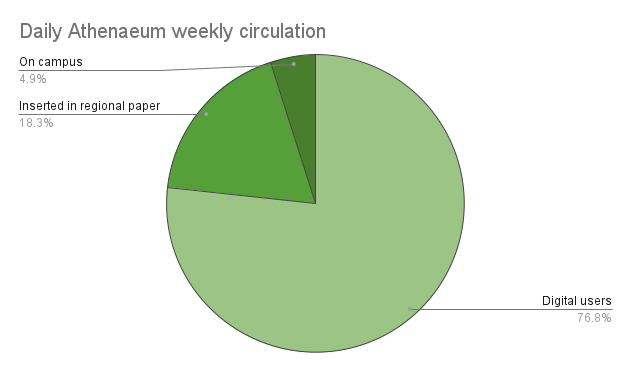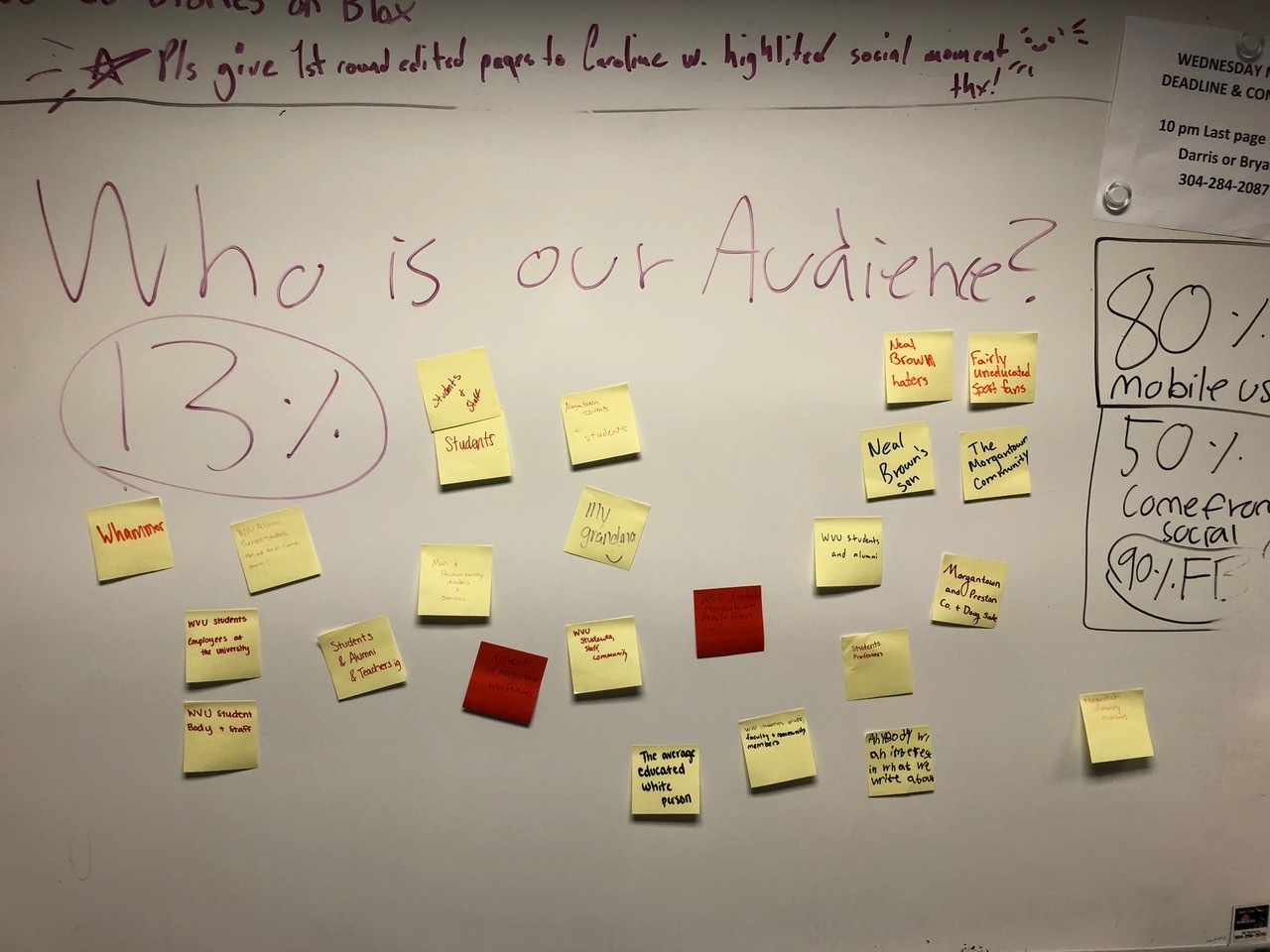The Lead is a weekly newsletter that provides resources and connections for student journalists in both college and high school. Sign up here to have it delivered to your inbox every Wednesday morning during the school year.
By Duncan Slade, West Virginia University
It started with a whiteboard, a box of Sharpies and four packs of sticky notes.
In mid-October, I called a meeting with the full editorial staff of The Daily Athenaeum, West Virginia University’s independent student newspaper. On sticky notes, every reporter and editor wrote down who they believed our audience was.
The answers were all over the place: “students,” “my grandma,” and “fairly uneducated sports fans.”
For several years, we’ve called ourselves a digital-first publication but we haven’t acted like it.
Almost all of our content was published on the same morning as our weekly print newspaper and the newsroom schedule revolved around print. We would even withhold stories from the website for several days after they were completed so that they could go in the print paper.
After discussing the sticky notes, I presented a chart showing the paper’s weekly circulation based on data from Google Analytics and print distribution numbers that we set at the beginning of the year. The data showed that our digital audience was three times our print audience. As a newsroom, we spent hours each week crafting the print product and were neglecting the much larger digital audience.

Courtesy
At this meeting and in the weeks that followed, we segmented our audience into three camps:
Print: Faculty, staff and some students who pick up one of the 2,700 copies distributed on campus; town and county residents who get the newspaper inserted in the regional paper.
Website: Parents and alumni. 53% of our website traffic is from readers over the age of 45, while another 25% is from readers between 35-44. Facebook drives a lot of our traffic.
Newsletter: Students. Roughly 18,000 WVU students open and read our weekly newsletter. That’s over half the student body. Many students read the newsletter but do not click through to the website.
After we had a clear picture of these three audiences, we moved toward digital-first publishing. What follows are the three most significant steps we took to improve our news product(s).
Publish constantly
The print and digital audiences are two separate groups with different information needs. The print audience wants news at a slower pace and with more context. The digital audience wants to know what is happening right now.
When breaking news happens, we publish an initial story, sometimes several, and then combine several stories for the print edition. We also publish stories throughout the week and no longer hold stories for the print edition.
In November, WVU President Gordon Gee came under fire for his involvement in advising the University of Austin, a project that aims to maintain free speech and fix higher education. We published an initial story about his involvement, a second story later that day after he released a statement and a third story based on comments he made at a public meeting. The third story was adapted with reporting from the first two and ran on the front page of our print edition a couple of days later.
The digital readers received the news in stories as it happened. The print audience got the same story, but with more context and reporting. By thinking about these two audiences separately, we can make smarter editorial decisions.
Unique audiences, different stories
Every week, we decide which stories go on the print front page and which story will lead the weekly newsletter to students two days later.
As we decide which two stories will be on the front, we’re focused on giving the print audience of faculty, staff and local residents the info they need. Stories about how to get tested for COVID-19 and about the construction of a new major campus building were both on the front page because they delivered news relevant to the print audience.
Those same stories were not placed prominently in the newsletter. In the newsletter, we focus on stories that students care about, such as the reopening of a popular nightclub and a well-known local sandwich shop owner selling his business while facing charges for involvement in the Jan. 6 riots.
Experiment always
Moving to digital-first publishing took several months. It was difficult to establish meaningful digital deadlines and there was pushback from some staff about the changes.
But we’re not done making changes. This spring, we’re conducting a readership survey to learn more about our audience’s information needs so we can better serve them.
Student journalism is a place to try new ideas and see what works. We continue to experiment with new ways to engage our various audiences. In recent weeks, we used the newsletter to get in touch with a guy who walks his pet bunny around campus and even ask people about their sex life.
The results of digital-first publishing have been dramatic. Online readership is up 128% over last year, almost every print copy is picked up from newsstands and our student audience is bringing story ideas to us.
Our advice to other student newsrooms: Try a new type of story or new presentation. Try publishing stories on different days of the week. If it doesn’t work, try something else.
Duncan Slade is the editor-in-chief of The Daily Athenaeum, the independent student-run newspaper of West Virginia University.
More from this series
This newsletter issue is part of an ongoing series about platforms and news distribution. Read the previous issue, which focused on how student newsrooms can use audience data to rethink strategies for reaching their readers.
One story worth reading
How should you be using social media content from Ukraine? Which political commentators are actually experts? Al Tompkins and Kelly McBride wrote for Poynter about ethical considerations for every newsroom as Russia continues invading Ukraine.
This story isn’t just an international one; it likely affects students on your campus. My editor Barbara Allen gathered some ideas and resources for students approaching the issue for their publications.
Opportunities and trainings
- Register for The Nation’s free student journalism conference, to be held virtually March 4.
- The Seattle Times is hosting a free student journalist workshop on reporting on Title IX and sexual misconduct. (I’m organizing this for my day job at the Times, and I’m really excited about it!) Register here for the March 9 event.
- High school seniors, consider applying for your state’s Journalist of the Year contest this spring. Deadlines vary by state.
- Register for ONA’s free career day event, to be held virtually March 31.
- Register for the JEA/NSPA National High School Journalism Convention, to be held in Los Angeles April 7-9.
- High school students, enter The New York Times’ student editorial contest by April 13.









